Hongtao Wu
Semi-Supervised Video Desnowing Network via Temporal Decoupling Experts and Distribution-Driven Contrastive Regularization
Oct 10, 2024



Abstract:Snow degradations present formidable challenges to the advancement of computer vision tasks by the undesirable corruption in outdoor scenarios. While current deep learning-based desnowing approaches achieve success on synthetic benchmark datasets, they struggle to restore out-of-distribution real-world snowy videos due to the deficiency of paired real-world training data. To address this bottleneck, we devise a new paradigm for video desnowing in a semi-supervised spirit to involve unlabeled real data for the generalizable snow removal. Specifically, we construct a real-world dataset with 85 snowy videos, and then present a Semi-supervised Video Desnowing Network (SemiVDN) equipped by a novel Distribution-driven Contrastive Regularization. The elaborated contrastive regularization mitigates the distribution gap between the synthetic and real data, and consequently maintains the desired snow-invariant background details. Furthermore, based on the atmospheric scattering model, we introduce a Prior-guided Temporal Decoupling Experts module to decompose the physical components that make up a snowy video in a frame-correlated manner. We evaluate our SemiVDN on benchmark datasets and the collected real snowy data. The experimental results demonstrate the superiority of our approach against state-of-the-art image- and video-level desnowing methods.
GR-2: A Generative Video-Language-Action Model with Web-Scale Knowledge for Robot Manipulation
Oct 08, 2024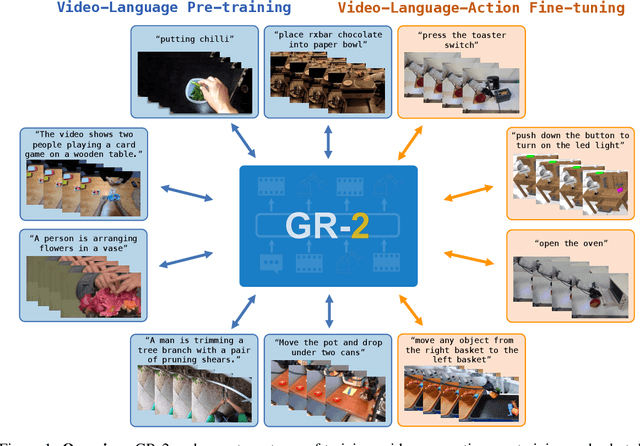
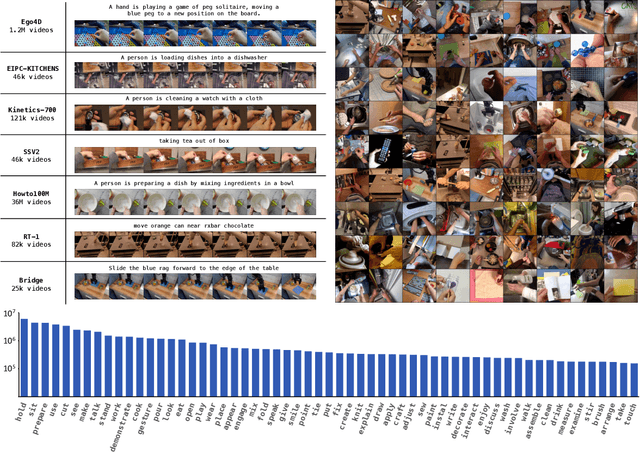
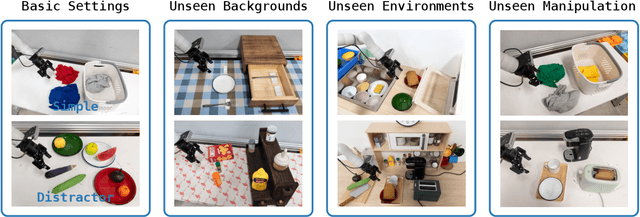
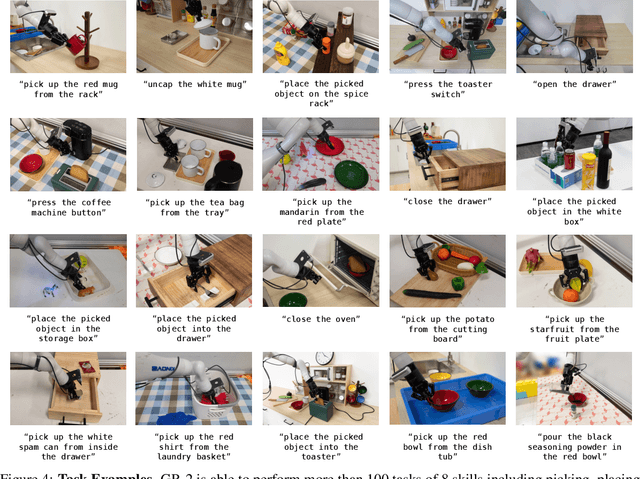
Abstract:We present GR-2, a state-of-the-art generalist robot agent for versatile and generalizable robot manipulation. GR-2 is first pre-trained on a vast number of Internet videos to capture the dynamics of the world. This large-scale pre-training, involving 38 million video clips and over 50 billion tokens, equips GR-2 with the ability to generalize across a wide range of robotic tasks and environments during subsequent policy learning. Following this, GR-2 is fine-tuned for both video generation and action prediction using robot trajectories. It exhibits impressive multi-task learning capabilities, achieving an average success rate of 97.7% across more than 100 tasks. Moreover, GR-2 demonstrates exceptional generalization to new, previously unseen scenarios, including novel backgrounds, environments, objects, and tasks. Notably, GR-2 scales effectively with model size, underscoring its potential for continued growth and application. Project page: \url{https://gr2-manipulation.github.io}.
World Model-based Perception for Visual Legged Locomotion
Sep 25, 2024Abstract:Legged locomotion over various terrains is challenging and requires precise perception of the robot and its surroundings from both proprioception and vision. However, learning directly from high-dimensional visual input is often data-inefficient and intricate. To address this issue, traditional methods attempt to learn a teacher policy with access to privileged information first and then learn a student policy to imitate the teacher's behavior with visual input. Despite some progress, this imitation framework prevents the student policy from achieving optimal performance due to the information gap between inputs. Furthermore, the learning process is unnatural since animals intuitively learn to traverse different terrains based on their understanding of the world without privileged knowledge. Inspired by this natural ability, we propose a simple yet effective method, World Model-based Perception (WMP), which builds a world model of the environment and learns a policy based on the world model. We illustrate that though completely trained in simulation, the world model can make accurate predictions of real-world trajectories, thus providing informative signals for the policy controller. Extensive simulated and real-world experiments demonstrate that WMP outperforms state-of-the-art baselines in traversability and robustness. Videos and Code are available at: https://wmp-loco.github.io/.
GR-MG: Leveraging Partially Annotated Data via Multi-Modal Goal Conditioned Policy
Aug 26, 2024Abstract:The robotics community has consistently aimed to achieve generalizable robot manipulation with flexible natural language instructions. One of the primary challenges is that obtaining robot data fully annotated with both actions and texts is time-consuming and labor-intensive. However, partially annotated data, such as human activity videos without action labels and robot play data without language labels, is much easier to collect. Can we leverage these data to enhance the generalization capability of robots? In this paper, we propose GR-MG, a novel method which supports conditioning on both a language instruction and a goal image. During training, GR-MG samples goal images from trajectories and conditions on both the text and the goal image or solely on the image when text is unavailable. During inference, where only the text is provided, GR-MG generates the goal image via a diffusion-based image-editing model and condition on both the text and the generated image. This approach enables GR-MG to leverage large amounts of partially annotated data while still using language to flexibly specify tasks. To generate accurate goal images, we propose a novel progress-guided goal image generation model which injects task progress information into the generation process, significantly improving the fidelity and the performance. In simulation experiments, GR-MG improves the average number of tasks completed in a row of 5 from 3.35 to 4.04. In real-robot experiments, GR-MG is able to perform 47 different tasks and improves the success rate from 62.5% to 75.0% and 42.4% to 57.6% in simple and generalization settings, respectively. Code and checkpoints will be available at the project page: https://gr-mg.github.io/.
RainMamba: Enhanced Locality Learning with State Space Models for Video Deraining
Jul 31, 2024



Abstract:The outdoor vision systems are frequently contaminated by rain streaks and raindrops, which significantly degenerate the performance of visual tasks and multimedia applications. The nature of videos exhibits redundant temporal cues for rain removal with higher stability. Traditional video deraining methods heavily rely on optical flow estimation and kernel-based manners, which have a limited receptive field. Yet, transformer architectures, while enabling long-term dependencies, bring about a significant increase in computational complexity. Recently, the linear-complexity operator of the state space models (SSMs) has contrarily facilitated efficient long-term temporal modeling, which is crucial for rain streaks and raindrops removal in videos. Unexpectedly, its uni-dimensional sequential process on videos destroys the local correlations across the spatio-temporal dimension by distancing adjacent pixels. To address this, we present an improved SSMs-based video deraining network (RainMamba) with a novel Hilbert scanning mechanism to better capture sequence-level local information. We also introduce a difference-guided dynamic contrastive locality learning strategy to enhance the patch-level self-similarity learning ability of the proposed network. Extensive experiments on four synthesized video deraining datasets and real-world rainy videos demonstrate the superiority of our network in the removal of rain streaks and raindrops.
IRASim: Learning Interactive Real-Robot Action Simulators
Jun 20, 2024



Abstract:Scalable robot learning in the real world is limited by the cost and safety issues of real robots. In addition, rolling out robot trajectories in the real world can be time-consuming and labor-intensive. In this paper, we propose to learn an interactive real-robot action simulator as an alternative. We introduce a novel method, IRASim, which leverages the power of generative models to generate extremely realistic videos of a robot arm that executes a given action trajectory, starting from an initial given frame. To validate the effectiveness of our method, we create a new benchmark, IRASim Benchmark, based on three real-robot datasets and perform extensive experiments on the benchmark. Results show that IRASim outperforms all the baseline methods and is more preferable in human evaluations. We hope that IRASim can serve as an effective and scalable approach to enhance robot learning in the real world. To promote research for generative real-robot action simulators, we open-source code, benchmark, and checkpoints at https: //gen-irasim.github.io.
Genuine Knowledge from Practice: Diffusion Test-Time Adaptation for Video Adverse Weather Removal
Mar 12, 2024Abstract:Real-world vision tasks frequently suffer from the appearance of unexpected adverse weather conditions, including rain, haze, snow, and raindrops. In the last decade, convolutional neural networks and vision transformers have yielded outstanding results in single-weather video removal. However, due to the absence of appropriate adaptation, most of them fail to generalize to other weather conditions. Although ViWS-Net is proposed to remove adverse weather conditions in videos with a single set of pre-trained weights, it is seriously blinded by seen weather at train-time and degenerates when coming to unseen weather during test-time. In this work, we introduce test-time adaptation into adverse weather removal in videos, and propose the first framework that integrates test-time adaptation into the iterative diffusion reverse process. Specifically, we devise a diffusion-based network with a novel temporal noise model to efficiently explore frame-correlated information in degraded video clips at training stage. During inference stage, we introduce a proxy task named Diffusion Tubelet Self-Calibration to learn the primer distribution of test video stream and optimize the model by approximating the temporal noise model for online adaptation. Experimental results, on benchmark datasets, demonstrate that our Test-Time Adaptation method with Diffusion-based network(Diff-TTA) outperforms state-of-the-art methods in terms of restoring videos degraded by seen weather conditions. Its generalizable capability is also validated with unseen weather conditions in both synthesized and real-world videos.
Unleashing Large-Scale Video Generative Pre-training for Visual Robot Manipulation
Dec 21, 2023



Abstract:Generative pre-trained models have demonstrated remarkable effectiveness in language and vision domains by learning useful representations. In this paper, we extend the scope of this effectiveness by showing that visual robot manipulation can significantly benefit from large-scale video generative pre-training. We introduce GR-1, a straightforward GPT-style model designed for multi-task language-conditioned visual robot manipulation. GR-1 takes as inputs a language instruction, a sequence of observation images, and a sequence of robot states. It predicts robot actions as well as future images in an end-to-end manner. Thanks to a flexible design, GR-1 can be seamlessly finetuned on robot data after pre-trained on a large-scale video dataset. We perform extensive experiments on the challenging CALVIN benchmark and a real robot. On CALVIN benchmark, our method outperforms state-of-the-art baseline methods and improves the success rate from 88.9% to 94.9%. In the setting of zero-shot unseen scene generalization, GR-1 improves the success rate from 53.3% to 85.4%. In real robot experiments, GR-1 also outperforms baseline methods and shows strong potentials in generalization to unseen scenes and objects. We provide inaugural evidence that a unified GPT-style transformer, augmented with large-scale video generative pre-training, exhibits remarkable generalization to multi-task visual robot manipulation. Project page: https://GR1-Manipulation.github.io
Vision-Language Foundation Models as Effective Robot Imitators
Nov 06, 2023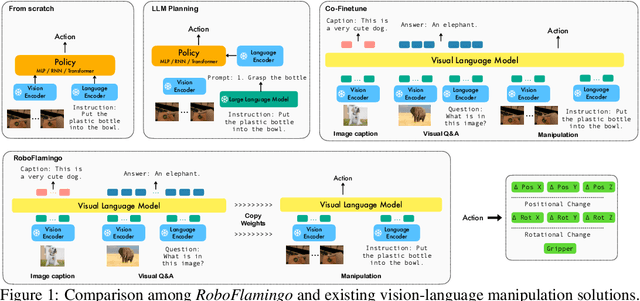
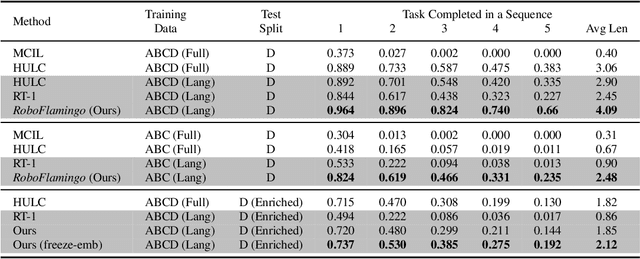
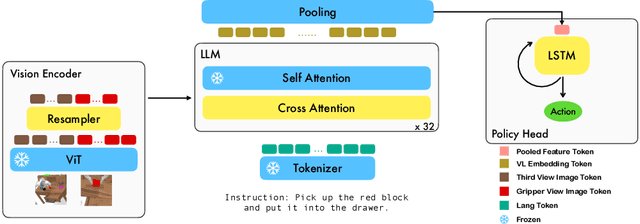
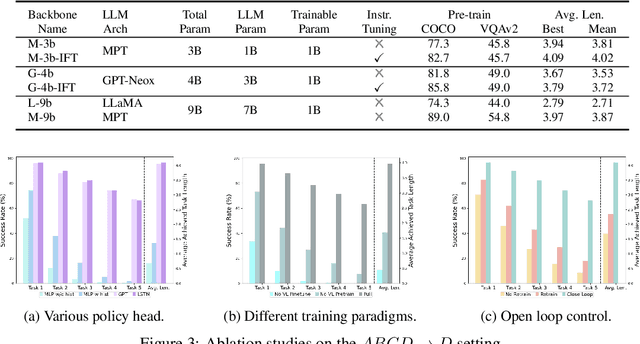
Abstract:Recent progress in vision language foundation models has shown their ability to understand multimodal data and resolve complicated vision language tasks, including robotics manipulation. We seek a straightforward way of making use of existing vision-language models (VLMs) with simple fine-tuning on robotics data. To this end, we derive a simple and novel vision-language manipulation framework, dubbed RoboFlamingo, built upon the open-source VLMs, OpenFlamingo. Unlike prior works, RoboFlamingo utilizes pre-trained VLMs for single-step vision-language comprehension, models sequential history information with an explicit policy head, and is slightly fine-tuned by imitation learning only on language-conditioned manipulation datasets. Such a decomposition provides RoboFlamingo the flexibility for open-loop control and deployment on low-performance platforms. By exceeding the state-of-the-art performance with a large margin on the tested benchmark, we show RoboFlamingo can be an effective and competitive alternative to adapt VLMs to robot control. Our extensive experimental results also reveal several interesting conclusions regarding the behavior of different pre-trained VLMs on manipulation tasks. We believe RoboFlamingo has the potential to be a cost-effective and easy-to-use solution for robotics manipulation, empowering everyone with the ability to fine-tune their own robotics policy.
MOMA-Force: Visual-Force Imitation for Real-World Mobile Manipulation
Aug 07, 2023



Abstract:In this paper, we present a novel method for mobile manipulators to perform multiple contact-rich manipulation tasks. While learning-based methods have the potential to generate actions in an end-to-end manner, they often suffer from insufficient action accuracy and robustness against noise. On the other hand, classical control-based methods can enhance system robustness, but at the cost of extensive parameter tuning. To address these challenges, we present MOMA-Force, a visual-force imitation method that seamlessly combines representation learning for perception, imitation learning for complex motion generation, and admittance whole-body control for system robustness and controllability. MOMA-Force enables a mobile manipulator to learn multiple complex contact-rich tasks with high success rates and small contact forces. In a real household setting, our method outperforms baseline methods in terms of task success rates. Moreover, our method achieves smaller contact forces and smaller force variances compared to baseline methods without force imitation. Overall, we offer a promising approach for efficient and robust mobile manipulation in the real world. Videos and more details can be found on \url{https://visual-force-imitation.github.io}
 Add to Chrome
Add to Chrome Add to Firefox
Add to Firefox Add to Edge
Add to Edge